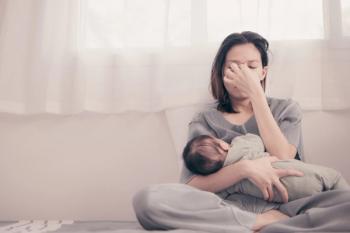
- Vol 65 No 05
- Volume 65
- Issue 05
The last normal place in the hospital
Navigating patient care in L&D during the global COVID-19 pandemic gives one resident cause for pause and reflection. How would it manifest in pregnancy?
When the first patient suspected of having COVID-19 appeared on L&D, it was like the arrival of a pregnant celebrity. We tiptoed carefully around her room, minimizing our visits as much as possible. We found ourselves constantly hitting the refresh button on her pending SARS-CoV-2 lab result, awaiting confirmation that the coronavirus had finally arrived. Only one physician, the attending, was permitted at the patient’s delivery.
In those early days, the protocols for other COVID-19-positive adults in the hospital were well-established, but the rules for pregnant patients were still being created on the fly. Were new mothers permitted visitors while in labor? Would they be allowed to breastfeed? Would they be permitted to even meet their newborns immediately after birth?
We were not even quite sure how COVID-19 would manifest in pregnancy. Suddenly we were second-guessing all our previous diagnoses. Did the new admit in room 7 really have atypical preeclampsia, or was her isolated thrombocytopenia actually caused by the new coronavirus? That patient with the gastrointestinal bug waiting in triage…should she be tested, too?
Changes to our residency program came swiftly. An emergency meeting was called a few days after the virus hit our state. We were told we would be divided into two teams, with half of the residents scattered into skeleton crews across the hospital and the other half sent home as backup in case anyone was exposed or fell ill.
I already had been working straight through for a couple of weeks when I was told I would be staying for a couple weeks more. Spending so much time in the hospital meant that news about the Coronavirus reached me in bits and pieces. Each morning I would drive to work in the dark and learn on the radio how many people had died during the night. Then each evening as I drove home in the dark, I would learn how many had died during the day.
Meanwhile, things on L&D gradually started to change. It seemed like each day brought a new set of rules. In an effort to minimize co-mingling among staff, our anesthesia, midwifery, and family medicine teams stopped attending our normally boisterous morning sign-outs. Suddenly, everyone had to start wearing masks.
All things considered, however, not much had changed on our floor. It turns out that delivering a baby during a global pandemic does not differ much from the days before we had ever heard of COVID-19. Elective inductions were still going ahead. We did skin-to-skin and delayed cord-clamping. Even the pregnant women who were COVID-19-positive could still have a relatively “normal” birth experience, albeit in a room of people covered head to toe in protective gear.
In fact, it was “on the frontlines” that I felt the most the distant from the pandemic itself. I felt guilty responding to messages from family and old friends, those not in medicine but trapped in their homes by an invisible enemy ravaging their cities and towns. Hey! How is everything going? And after getting past the familiarities, So…what’s it like in there?
The truth is, I hardly felt like I was on the frontlines, maybe more frontline-adjacent. If battling COVID-19 is truly the violent conflict our president would have us believe it is, then I felt like I was still a few trenches away from the hand-to-hand combat.
That has not stopped us from adopting the language of soldiers. Residents speak of being deployed to the ICU. Plans are underway for a field hospital. Our daily briefings from administration quote Winston Churchill and urge us to “Stay the course.” The residents outwardly smile at this drama, but each still clings to their N95 mask like it’s a Kevlar vest.
After 3 weeks in the hospital, it was time for me to return home for my pandemic-mandated shore leave. I would be at home for another 2 weeks, enough time for any sign of an infection to manifest itself.
I had been working 14-hour days and overnight weekend call and had only a tangential understanding of how the outside world had changed during that time. It was a shock. When did they close all the restaurants? What do you mean I can’t have my friends over for dinner? What is “Zoom” and how do my parents know how to use it?
The first time someone walking toward me on the sidewalk swerved away to preserve my government-mandated 6 feet of personal space I nearly burst out laughing. Later that day I texted my fiancé from the supermarket, incredulous. Do you know they’ve hired someone whose job is to wipe down all the supermarket carts?
My own sense of hubris started to creep in slowly. At the hospital, passing a sign each day that cheerfully implored me to Thank our healthcare workers!, I had lost touch with the awfulness of this disease. In this otherwise anxious world we now inhabit, it had been wonderful to do something as joyful as deliver babies every day. All the while, three floors above me, patients were dying on ventilators.
It was only after I left the wards that I really began to be afraid of COVID-19, after I was able to step back and see the bas-relief impression it had left in the world outside of the hospital. Now I sit glued to the radio for updates on the virus. I read articles from China on its effects on pregnant patients and brush up on the pathophysiology of ARDS. I call my parents every day. We “Zoom.”
As I write this, I am getting ready to return to the hospital. I know from my co-residents and from the numerous update emails from my department that things are different now. We are accepting transfers from inundated hospitals in the area and sanitizing and reusing dwindling supplies of PPE. COVID-19-positive pregnant women have had bad outcomes directly related to the virus. The world at my hospital is starkly different from the one I left-and it may have changed yet again by the time you read these words.
Physicians, especially those in training, are known for using humor to ride out difficult times. When I return to L&D, I will likely try my best to smile, joke, and commiserate with my co-residents. But beneath a stifling N95 mask, I will be gritting my teeth.
Articles in this issue
over 5 years ago
Additional studies needed on drugs for osteoporosisover 5 years ago
Cervicovaginal microbiome and HPV progressionover 5 years ago
Vasomotor symptoms and faster epigenetic agingover 5 years ago
How are miscarriages discussed on social media?over 5 years ago
‘Momnibus’ legislation aims to help black momsover 5 years ago
Managing BRCA results from 23andMeover 5 years ago
Liletta IUS: not just for long-term contraceptionover 5 years ago
Vulvovaginal atrophy among breast cancer survivorsNewsletter
Get the latest clinical updates, case studies, and expert commentary in obstetric and gynecologic care. Sign up now to stay informed.
















